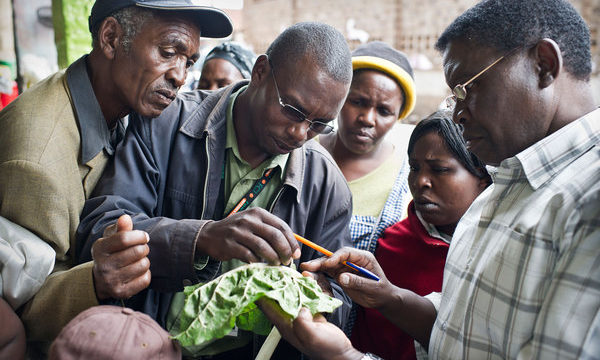The detection of the Asian citrus psyllid (Diaphorina citri) in a citrus grove in Ventura County, California, has set alarm bells ringing in the Californian citrus industry, and led to the imposition of a quarantine in the County just as the citrus harvest was getting under way. The psyllid, now found throughout Florida and present in a number of other U.S. states, is a serious pest of citrus, and is the primary vector for citrus greening (also called Huanglongbing or HLB), one of the more serious diseases of these fruit crops. All citrus and closely related species are susceptible hosts for both the insect and the disease, and there is no cure once a tree is infected with HLB.
Californian officials have quarantined all of Ventura County and a small portion of neighboring Santa Barbara County, prohibiting movement of nursery stock from the area and requiring all citrus fruit to be cleaned of leaves and stems before leaving the quarantined zone. Fruit can, however, be taken to a packing house in the County to be commercially washed and packed, after which it is no longer a host for the pest and can be sent to market.
A concern for Californian growers is that Ventura County is the furthest north the psyllid has so far been detected in California. California Citrus Research Board President Ted Batkin said the Ventura discoveries mark the first new location for the psyllid since September, and that it could could survive in climates as far north as Washington and Oregon. Citrus growing is a $1.8 billion industry in California.
The Porterville Recorder reports that the state of Florida first detected the pest in 1998 and the disease in 2005, and the two have now been detected in all 30 citrus producing counties in that state. The pest and the disease are also present in Louisiana, Georgia and South Carolina. The states of Texas, Mississippi and Alabama have detected the pest but not the disease. The virus has been blamed for the destruction of more than 65,000 acres of citrus groves in Florida.
A Pest Alert from APHIS first reported the Asian citrus psyllid in California in September 2, 2008, on a lemon tree about 11 miles north of the international border with Mexico, where the pest is also present. The disease HLB is also present in Mexico, with central Mexico just north of Mazatlan being the closest to California that HLB is present. A Pest Alert posted on 28 August 2008 confirmed its presence in Alabama, Georgia, Mississippi and South Carolina.
CAB Abstracts contains over 450 bibliographic records on the psyllid, and over 500 on HLB. See below for some references relevant to its distribution and risk in the USA.
For further information on the pest in the USA, see also the APHIS datasheet.
References
Asian citrus psyllid (Hemiptera: Psyllidae) and citrus greening disease in Louisiana. Hummel, N. A.; Ferrin, D. M.; Southwestern Entomologist, 2010, 35, 3, pp 467-469, 5 ref.
Asian citrus psyllids (Sternorrhyncha: Psyllidae) and greening disease in citrus: a literature review and assessment of risk in Florida. Halbert, S. E.; Manjunath, K. L.; Florida Entomologist, 2004, 87, 3, pp 330-353, many ref.
Abundance of Asian citrus psyllid on yellow sticky traps in Florida, Puerto Rico, and Texas citrus groves. Flores, D.; Hall, D. G.; Jenkins, D. A.; Setamou, M.; Southwestern Entomologist, 2009, 34, 1, pp 1-11, 20 ref.
Incidence of invasive Diaphorina citri (Hemiptera: Psyllidae) and its introduced parasitoid Tamarixia radiata (Hymenoptera: Eulophidae) in Florida citrus. Qureshi, J. A.; Rogers, M. E.; Hall, D. G.; Stansly, P. A. Journal of Economic Entomology, 2009, 102, 1, pp 247-256, 40 ref. [PDF file]
Distribution of the Asian citrus psyllid, Diaphorina citri Kuwayama (Rhynchota: Psyllidae) in the Caribbean Basin. Halbert, S. E.; Núñez, C. A. Florida Entomologist, 2004, 87, 3, pp 401-402, 9 ref.
Related News & Blogs
Citrus Greening in Grenada
[youtube https://www.youtube.com/watch?v=KNlZQMRDNBU&w=560&h=315] Citrus Greening, also known as Huanglongbing, was first confirmed in Grenada in 2016. The disease is caused by bacteria which are spread by the Citrus psyllid. The disease causes…
20 September 2017


